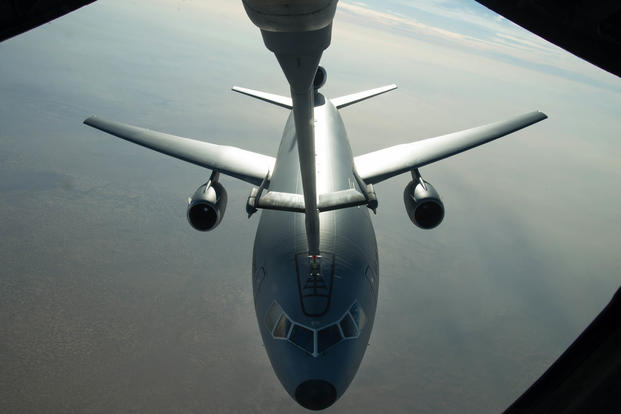Gen. Carlton Everhart II is head of the Air Force's Air Mobility Command.
The U.S. Air Force's Air Mobility Command plays a crucial role in U.S. national defense, but it also serves as an extension of international diplomacy.
Mobility airmen provide our nation unfaltering airlift, air refueling, en route support and in-flight medical care -- so unfaltering that our nation is in danger of viewing these mobility capabilities as national birthrights rather than an enduring strategic investment.
Rapid global mobility is the kind of airpower our nation requires and our joint and coalition partners expect. The United States is the only nation able to mobilize and project power globally within a moment's notice, providing a game-changing national defense advantage. These multi-role international effects are at risk.
The need for airlift, air refueling, en-route support and aeromedical care will remain in demand, but will face increased vulnerability in a rapidly evolving global dynamic. Unpredictable budgets, an aging aircraft fleet, pilot shortages and playing catch-up to an evolving threat environment are several pressing challenges Air Mobility Command faces.
Air Mobility Command, headquartered at Scott Air Force Base, Illinois, is the steward of these vital national mobility capabilities. It also flies the president of the United States aboard Air Force One. These capabilities are pillars of U.S. military strength, global reach and a key part of what makes the United States a military power.
Expeditionary Mobility Airmen are deployed to 77 locations in 23 countries and their hard work enables AMC aircraft to take off every 2.8 minutes somewhere around the globe. In 2016 alone, our airmen flew 75,000-plus sorties, transported 913,000 passengers and warriors, moved more than 4,000 patients and transferred 1.2 billion pounds of fuel to thirsty aircraft. For the year, AMC activity touched 173 countries and resulted in more than 577,000 hours in the sky. This is roughly equivalent to 24,000 days or nearly 66 continuous years in the air.
While we provide a daily impact to global, kinetic missions, the mission value extends beyond traditional military effects.
U.S. mobility aircraft represent "gray-tail diplomacy" with our airmen creating critical first impressions and the U.S. flag proudly displayed on our aircraft. Our airmen are often the first ones on the ground conducting humanitarian assistance after a natural disaster, and the people they're helping see the U.S. flag on our aircraft. That same flag is displayed on our presidential airlift platform -- Air Force One. When we put our aeromedical evacuation teams to work, the patients they care for see that flag on the crews' shoulders and their actions demonstrate the values in the hearts of mobility airmen. AMC, U.S. Air Force airmen and families serving are making a difference.
As impressive as this may be, these effects are being achieved with far less capability than we had in the 1990s, prior to budget constraints.
Let's consider the tanker fleet. In the 1990s, the AMC tanker fleet stood at 600 aircraft strong. Today, there are 455 total force active-duty, Guard and Reserve tanker aircraft available to the nation. Demand for this capability hasn't gone down, placing significant stress on the fleet.
Consider that mobility tankers alone comprise 40 percent of the total U.S. Air Force contribution to fighting the Islamic State of Iraq and Syria, or ISIS, with our airmen refueling one aircraft every five minutes in the U.S. Central Command area of responsibility. Mobility airmen airlift equipment, supplies and people into places such as the Middle East. AMC airmen, for example, established the airfield at Qayyarah West, enabling the fight against ISIS in Mosul.
Mobility airmen are required to overcome the tyranny of distance and ensure timely response to any crisis around the globe. Over the years, uncertain access to foreign soil has resulted in enhanced reliance on airlift and refueling capability.
Our airmen sustain an incredibly high operational tempo and have for a long time. Service is in their hearts and they are producing tremendous effects in aircraft considered antiques in civilian terms. The average age of KC-135s is 55 years old; some are 60-plus years old. The world continues to change at a rapid pace, but some of the platforms we expect airmen to operate remain fixed and dated.
The civilian industry continues to heavily recruit our highly trained pilots and maintainers. We've had to cut our maintenance ranks and now we're paying the price.
To mitigate a very real risk to our national security, we're going to have to modernize our fleet, work with the civilian aviation industry to seek the best way forward on the pilot shortage without decimating our ranks and utilize technology and maintenance practices existing in the airlines to position the force for the future.
We have already started collaborating with our airline partners in search of strategic solutions. It's imperative that we find a way forward. In the next four years, 1,600 mobility pilots will be eligible to separate from the service.
We must overcome our struggles with modernizing our capabilities and position our aircraft and people to operate and deliver in increased threat environments.
To that end, we are co-sponsoring a High Value Airborne Asset Assessment with the Defense Department to explore improving the survivability of the mobility fleet. We must learn with our industry partners, exploring concepts across the total active-duty, Reserve and Guard force to reduce wear-and-tear on our aging fleet.
We're at a point where we are making tough choices as our capacity to support ever-evolving global missions drives increased demand -- and without a strong mobility presence, the ability to achieve strategic military and diplomatic effects is eroded.
We're simply too small for the missions our nation and the world expects us to deliver.
-- If you would like to submit your own commentary, please send your article to opinions@military.com for consideration.





























